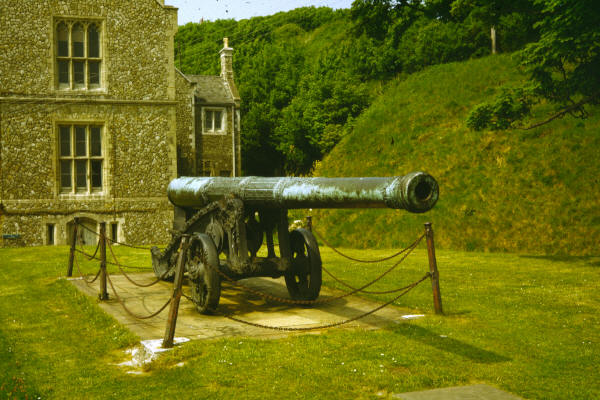"The most popular "lion" of the castle is a long gun exhibited on
a stand near Canon Gate. Up to the year 1827 it occupied a wooden
stand near the cliff edge, but in that year the Duke of Wellington, as
Master General of the Ordnance, had its present iron stand cast from the
metal of guns brought from the field of Waterloo. A contributor to
the Gentleman's Magazine in 1767, gave a description of the gun as
follows:- "On the most southern part of the cliffs, which form the
platform of Dover Castle, lies a brass gun, 24 feet long without, and 22
feet long in the bore, with these inscriptions raised on it in Roman
Capitals:-
Ian Tolhuys van Utrecht, 1554."
"This is supposed to be the founder's name. Under it is a
shield with six chevronels, quartering a fess indented; on the
escutcheon of pretence a saltire cheque. Motto:- "Sans aultre."
The arms of England in a garter with "Dieu at Mon Droit." Then
follows the inscription:-
"Brech scuret al muer ende wal
Bin ich geheten
Doer bergh en dal boert minen bal
Van mi gesmeten."
"Under an armed woman holding a spear and palm branch is the word
"Victoria." Under another woman, "Libertas." Under a river
god "Scalda." This curious gun, vulgarly called "Queen Elizabeth's
Pocket Pistol," the Gentleman's Magazine writer continues "was a present
from the Emperor Charles V. to Henry VIII., while they were engaged
together in a war with France. It requires 15lbs. of powder, and
will carry a ball seven or eight miles, or, as they say, to Calais."
We give the foregoing statement of the history of the gun because
it has been adopted by many writers. Opinions vary as to whether
the "pistol" was presented to Henry VIII. by Charles V., or, as the
inscription on the board near it asserts, by the States of Holland to
Queen Elizabeth. The latter opinion is best supported."
(JBJ 1916)
